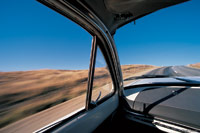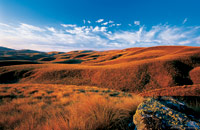 Central Otago History
Central Otago History
Central Otago | Regional Information | Activity Highlights | Scenic Highlights | History
Central Otago is a region touched by history, with a powerful landscape of ancient mountains, weathered rock formations, alpine herb fields and fast rivers.
Central Otago History Overview
In ancient times, Māori travelled through Central Otago on their way to the pounamu rivers of the west coast. Hunting parties also visited the region—they built rafts and used the Clutha River to transport moa and other game back to the east coast.

Photographer: Mark Smith
(mrmrsmith@clear.net.nz)
More recently, in the 1860s, Central Otago was the scene of a gold rush. Trails used by miners can still be seen winding over the hills. Stone cottages, a haunted hotel, cleverly engineered water channels, mines and machinery are other relics to discover. You can still try your luck with a gold pan, or be satisfied with the golden sweetness of a Roxburgh apricot.
Nowadays, Central Otago is the scene of a 'wine rush'. Pinot Noir has become one of the region's newest treasures, and many of the wineries welcome visitors for tours and tastings.
As a growing holiday region, there are lots of accommodation options in Central Otago. You can choose from conveniently placed motels, kiwi bed and breakfasts or self contained holiday homes. If you are travelling with your family, you can find family friendly accommodation or if cycling the Otago Central Rail Trail you can find rail trail accommodation.
Send an Otago related E-Postcard to your friends.
The Old Bridge Piers - a monument to early civil engineering
The Old Bridge Piers are the remains of the original Alexandra Bridge, which was completed in 1882 at a cost of £16,111 (NZ$32,222). This bridge crossed the mighty Clutha River, New Zealand's largest river by volume and second longest at 338 kilometres. The piers were constructed of schist stone quarried locally. The very first method of crossing the river was a packing case on a cable. This method was superseded by a punt, which ferried people across the river.
The name Clutha is taken from Scotland's Clyde River—Clutha being Gaelic for Clyde.
To the Māori people the river was Mata-au (surfaced current). A giant named Kopuwai and his pack of two-headed dogs were said to have lived above the Mata-au on the Old Man Range behind Alexandra. This range is known to Māori as Kopuwai.
» Old Bridge Piers Information
Otago Goldfields Heritage Trail
Like a giant outdoor museum, the Otago Goldfields Heritage Trail combines exciting walkways and mountain biking trails with opportunities to see the weathered remains of human endeavour from the 1860s.
You can pick and choose from more than 20 separate gold mining locations. Together they accurately portray the broad range of gold mining techniques developed by ingenious people who were driven by the chance of great riches.
When gold was discovered in Otago in 1861, thousands of miners poured into the region, causing similar scenes to the rushes of California and Australia. Gabriel's Gully is where it all began, and within seven months 10,000 miners flocked to this goldfield. With mine names like Dead Horse Pinch, Serpentine and Lonely Graves, the hardship and bleak optimism of gold fever is very much apparent. The Golden Progress Mine and Earnscleugh Dredge Tailings show how technology evolved during the rush.
By 1867, around two million ounces of gold had been taken out of Otago. This prosperous time had a major impact on the young New Zealand economy—the grand buildings of Dunedin city are one example of how Otago's riches were spent.
» Otago Goldfields Heritage Trail Information

Photographer: Gilbert van Reenen
(www.cleangreen.co.nz)
Teviot Woolshed
Standing in a paddock like a medieval stone relic, the remains of the Teviot Woolshed (erected 1870) look as though they could have been anything from ancient barracks to a factory or prison.
In fact, the structure was once the largest woolshed in the southern hemisphere. Measuring 137 by 47.3 metres it could hold more than 8,000 sheep. Stories suggest the shed came from England, where it had been a railway station before being dismantled and shipped all the way to New Zealand.
In 1924 much of the shed was destroyed by fire, however the stone walls with rounded facade and arched windows remain today. It's very easy to visualise the structure with its vast roof still in place and imagine either steam trains or long lines of sheep coming and going through the lofty archways.
Nearby, at the Horseshoe Bend diggings on the banks of the Clutha River, two much smaller stone structures have a different tale to tell. In an isolated spot two gravestones lie side-by side, one for William Rigney and the other for 'Somebody's Darling'.
Local legend tells us that in 1865 William Rigney discovered the body of a young man on the riverbank following a flood. He arranged an inquest and burial for the unknown man, erecting a headstone with the words 'Somebody's Darling Lies Buried Here'. Upon his death in January 1912, Rigney was buried as requested beside the anonymous grave.
Useful Central Otago Links
To help plan your Central Otago holiday choose from the main categories below:
- Central Otago Accommodation
- Central Otago Tours
- Central Otago Attractions and Activities
- Central Otago Transport
- Central Otago Cuisine and Dining
- Central Otago Shopping
- Central Otago Visitor Information
Useful Otago Links
To help plan your Otago holiday choose from the main categories below:
- Otago Accommodation
- Otago Tours
- Otago Attractions and Activities
- Otago Transport
- Otago Cuisine and Dining
- Otago Shopping
- Otago Visitor Information
Send an Otago related E-Postcard to your friends.
Otago Region Information
 Regional Information
Regional Information
Key information and facts about the Otago region.
 Activity Highlights
Activity Highlights
Major activities and attractions in the Otago region.
 Scenic Highlights
Scenic Highlights
Major natural attractions in the Otago region.
 History
History
History of the Otago region.
Otago Tourism Operators
Choose from our accommodation, attractions, tours, transport or visitor information categories below to find a tourism operator in Otago.















